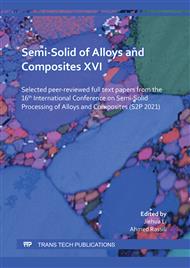p.105
p.111
p.119
p.127
p.133
p.140
p.149
p.156
p.163
Experimental and Numerical Study of the Effect of Pouring Temperature and Fluid Convection on Spherical Grains Formation
Abstract:
Spherical morphology is the typical characteristic of the microstructure in semi-solid slurries, while the formation mechanism of these spherical grains is still unclear, especially the migration of the solid-liquid interface under different process conditions. This study will focus on the effect of pouring temperature and swirling on the morphology of grains. A phase field-lattice-Boltzmann method using parallel computing and adaptive mesh refinement (Para-AMR) was employed to study the FCC α-Al phase evolution in binary Al-Si aluminum alloy. Study results represent that the pouring temperature has a significant influence on the morphology of the α-Al grains. Low pouring temperature is a benefit for the formation of spherical microstructures. And the swirling can refine the microstructure under high pouring temperature.
Info:
Periodical:
Pages:
133-139
Citation:
Online since:
January 2022
Authors:
Price:
Сopyright:
© 2022 Trans Tech Publications Ltd. All Rights Reserved
Share:
Citation:


